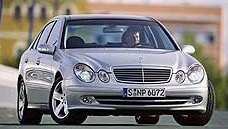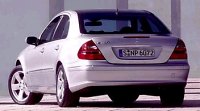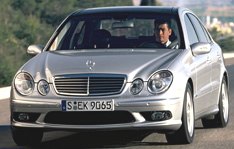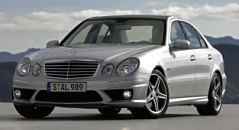 The
world is strange, isn’t it? we all know the outgoing E-class was
overshadowed
by BMW 5-series in most important area - from build quality to
dynamics,
but it easily outsold the 5er and every other rivals from day 1 to the
end. That said, 6 years on the top of sales chart, with an average of
200,000
cars found satisfying customers every year. Even more strange is that
while
Mercedes can charge premium price for the E-class, a large amount of
the
cars were sold as company cars, fleet cars, hotel cars and even Taxis.
Mass-market effect seems not able to downgrade the image of the
3-pointed
star. The
world is strange, isn’t it? we all know the outgoing E-class was
overshadowed
by BMW 5-series in most important area - from build quality to
dynamics,
but it easily outsold the 5er and every other rivals from day 1 to the
end. That said, 6 years on the top of sales chart, with an average of
200,000
cars found satisfying customers every year. Even more strange is that
while
Mercedes can charge premium price for the E-class, a large amount of
the
cars were sold as company cars, fleet cars, hotel cars and even Taxis.
Mass-market effect seems not able to downgrade the image of the
3-pointed
star.
After 6 strange years (which is strangely short by the standard of Mercedes-Benz), the E-class is renewed. New generation W211 looks as if the evolution of W210. The trademark quad circular headlamps are still there, as is the big grille. The whole body profile gets smoother and sleeker, lowering drag coefficient from 0.27 to 0.26 (for narrow-tyre E240). Dimension is nearly unchanged from the old car, just the 22mm longer wheelbase (now 2854mm, versus BMW 5-series' 2830mm) worth mentioning. Interior room - a strength of the old car already - is boosted by an extra 20mm rear passenger headroom. Otherwise there is no much surprise. Cabin
The cabin is spacious, bigger than its main rivals, especially rear passenger room. Driver comfort is excellent too, thanks to superb driving position and full degree of adjustment. If you want gimmicks, it will provide you the world's first active seat calling "Dynamic Multicontour". What is it ? it has several air bags which inflate during hard cornering to enhance lateral support and otherwise deflate to make it more comfortable. Perhaps a little bit over the top... more welcome is a 4-zone climate control which should satisfy different requirements for each passengers. Dynamic Thanks to the use of more high-strength steel, the chassis is 18% stronger than before. Better still is adequate weight control. Mercedes has applied its weight reduction know-how learned from CL coupe to this mass production model, using aluminum hood, front wings, doors, trunk lid and some inner cross members to cut weight. Order a lean E240 and you will find it 20kg lighter than before despite of the advancement of refinement and quality. Get a better-equipped E320, it is just 25kg heavier than before.
To confuse you, E240 actually runs a 2597c.c. V6 producing 177hp. It can be coupled to 5-speed automatic or 6-speed clutchless manual. As before, the Mercedes in-house-built automatic shift seamlessly, but the clutchless manual is cumbersome. E320 keeps the long-serving 3199c.c. V6 (224hp) unchanged. It is still a smooth and quiet unit by today’s standard. Though not as powerful as BMW’s 3.0 straight-six, it has wide spread of torque and mates perfectly with the 5-speed automatic. The old E430 has been replaced by E500. As suggested by its name, it runs the 306hp 5-litre V8 from S500 and SL500 etc. Mercedes’ V8 is renowned for lightweight, so the bigger engine can just lift driving excitement to new level without any drawback in handling. Pushing just 1605kg kerb weight, the V8 can do 0-60mph in an astonishing 5.8 seconds! remember, Mercedes still has an E55 AMG on the pipeline, therefore E500 is actually sell as a fast saloon rather than sport saloon. Handling This time, Mercedes determines to beat BMW in the latter’s backyard - handling. Everybody knows this is not an easy task, but the W211 is 6 years younger than the 5-series and has a big development budget. Moreover, it has 3 secret weapons: 1. All-new 4-link front suspensions, replacing the old double-wishbones. It has better control of camber, dive and squat, enhancing front-end grip and therefore minimizing understeer. The rear multi-link suspensions are now made of aluminum to cut unsprung weight, hence better ride comfort. 2. Airmatic DC: previously used in S-class only, the Airmatic is an adaptive air springing which alter spring rate according to road conditions, speed and driving style, also lower ride height at high speed. Airmatic DC now adds a 4-setting adaptive damping as well to further improve ride comfort and body control. Airmatic DC is standard on E320 and E500, and optional to other models. 3. A new speed-sensitive steering rack with quicker ratio (2.8 turns compare with 3.3 of the old car).
Get a E500 with Avantgarde (stiffer and 15mm lower) suspensions and Airmatic DC, it can even overshadow 540i in any area. The adaptive suspensions firm up in corner, improving stability and grip. As a result, the car changes direction eagerly, corners in tight bends fluently. But best of all, it does all these so easily because of the supple ride, smooth engine / transmission combo, light controls and quiet cabin. E-class finally beats the mighty 5-series convincingly. Conclusion I would prefer the new E-class to have higher quality cabin and a prettier front-end styling, but its superb comfort and excellent dynamics are already enough to place it on the top of executive class. So, congratulation to Mercedes! Just watch out
next year’s
new 5-series. I would be surprised if BMW not to take a big step
forward
again. |
| The above report was last updated on 20 May 2002. All Rights Reserved. |
 Owing
to cost cutting, the previous E-class was notorious about build quality
- wide assembly gap, cheap plastics and switch gears, poor finish paint
etc. Mercedes has learned the lesson and now you can see the visual
quality
of new E-class has much improved. Shut the doors and you will feel the
structure is far more solid. Panel gaps are narrower, dashboard
material
and assembly are better. However, you can still feel this is not the
Mercedes
of the "good old days". It still trails Audi and BMW in build quality,
which is disappointing considering the new car has 6 or so years ahead
to spend its life.
Owing
to cost cutting, the previous E-class was notorious about build quality
- wide assembly gap, cheap plastics and switch gears, poor finish paint
etc. Mercedes has learned the lesson and now you can see the visual
quality
of new E-class has much improved. Shut the doors and you will feel the
structure is far more solid. Panel gaps are narrower, dashboard
material
and assembly are better. However, you can still feel this is not the
Mercedes
of the "good old days". It still trails Audi and BMW in build quality,
which is disappointing considering the new car has 6 or so years ahead
to spend its life.  Engine
remains to be the 3-valve-per-cylinder modular family of V6 and V8,
plus
the new 2.0-litre supercharged four-pot and some turbo diesels.
Engine
remains to be the 3-valve-per-cylinder modular family of V6 and V8,
plus
the new 2.0-litre supercharged four-pot and some turbo diesels.
 In
real world, the new E-class really surprises us. Its steering is light,
communicative and accurate. Body control - even on conventional
suspension
models - is very good while ride quality is smoother than BMW. No
matter
around town or motorway, no matter at any speed, the Mercedes deals
with
minimum fuss, offering great comfort and quietness unfound in rivals.
High
speed stability and braking (by brake-by-wire SBC) are also excellent.
In
real world, the new E-class really surprises us. Its steering is light,
communicative and accurate. Body control - even on conventional
suspension
models - is very good while ride quality is smoother than BMW. No
matter
around town or motorway, no matter at any speed, the Mercedes deals
with
minimum fuss, offering great comfort and quietness unfound in rivals.
High
speed stability and braking (by brake-by-wire SBC) are also excellent.
 As
the usual practice of Mercedes-Benz, E-class gets a facelift 4 years
after its birth. Outside, it gets revised bumpers, grille and
headlamps, though the changes are so subtle that you need careful eyes
to notice. Automotive journalists might demand more spectacular changes
to attract readers, but German prestige car makers always prefer subtle
evolution, as it is good to the consistency of brand image and good to
the resale value of used cars.
As
the usual practice of Mercedes-Benz, E-class gets a facelift 4 years
after its birth. Outside, it gets revised bumpers, grille and
headlamps, though the changes are so subtle that you need careful eyes
to notice. Automotive journalists might demand more spectacular changes
to attract readers, but German prestige car makers always prefer subtle
evolution, as it is good to the consistency of brand image and good to
the resale value of used cars. The
unbeatable M5 has been beaten finally. Today, we announce that Mercedes
E55 AMG replaces M5 as the new ruler of the sports sedan segment. This
is hardly surprising after the regular E-class beat the 5-series last
year.
The
unbeatable M5 has been beaten finally. Today, we announce that Mercedes
E55 AMG replaces M5 as the new ruler of the sports sedan segment. This
is hardly surprising after the regular E-class beat the 5-series last
year.
 When
AMG replaces E55 with E63, car enthusiasts can't help doubting whether
the new naturally-aspirated 6.2-litre V8 can really outshine its
supercharged 5.5-litre predecessor. Switching to natural aspiration
means it lost 0.8 bar boost pressure. On the plus side, the new engine
is a clean sheet design from AMG. It gains many good technologies
compare to its conservative predecessor, such as 4 valves per cylinder,
fully variable valve timing, 2-stage intake manifolds,
friction-reducing TWAS cylinder coating, 11.3:1 compression and race
car-style crankcase with close-deck bedplate. The question is, can the
higher efficiency compensate the lost of supercharger?
When
AMG replaces E55 with E63, car enthusiasts can't help doubting whether
the new naturally-aspirated 6.2-litre V8 can really outshine its
supercharged 5.5-litre predecessor. Switching to natural aspiration
means it lost 0.8 bar boost pressure. On the plus side, the new engine
is a clean sheet design from AMG. It gains many good technologies
compare to its conservative predecessor, such as 4 valves per cylinder,
fully variable valve timing, 2-stage intake manifolds,
friction-reducing TWAS cylinder coating, 11.3:1 compression and race
car-style crankcase with close-deck bedplate. The question is, can the
higher efficiency compensate the lost of supercharger? The answer is both yes and no -
yes in terms of horsepower, no in terms of torque. The new engine pumps
out 514 horsepower at 6800rpm, some 38hp more than the old engine could
muster (by the way, more than BMW M5's 507hp). It can rev to 7200rpm,
more like a small-capacity engine than a big V8. On the other hand, it
can produce as much as 465 lbft of torque at 5200rpm, way more than
M5's 383 lbft, but still fails to match the old supercharged engine's
516 lbft. Moreover, the old engine had its max torque available
from 2650 continuously to 4500rpm.
The answer is both yes and no -
yes in terms of horsepower, no in terms of torque. The new engine pumps
out 514 horsepower at 6800rpm, some 38hp more than the old engine could
muster (by the way, more than BMW M5's 507hp). It can rev to 7200rpm,
more like a small-capacity engine than a big V8. On the other hand, it
can produce as much as 465 lbft of torque at 5200rpm, way more than
M5's 383 lbft, but still fails to match the old supercharged engine's
516 lbft. Moreover, the old engine had its max torque available
from 2650 continuously to 4500rpm.  The
higher performance is matched by more powerful brakes - up front are
6-pot calipers and 360mm composite discs, at the rear are 4-pot
calipers and 330mm discs. The braking is strong and fade free, an
advantage against M5.
The
higher performance is matched by more powerful brakes - up front are
6-pot calipers and 360mm composite discs, at the rear are 4-pot
calipers and 330mm discs. The braking is strong and fade free, an
advantage against M5.